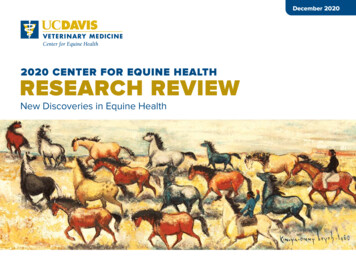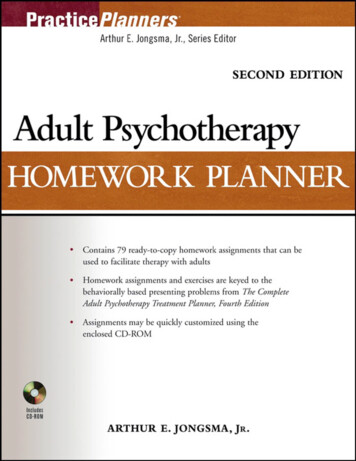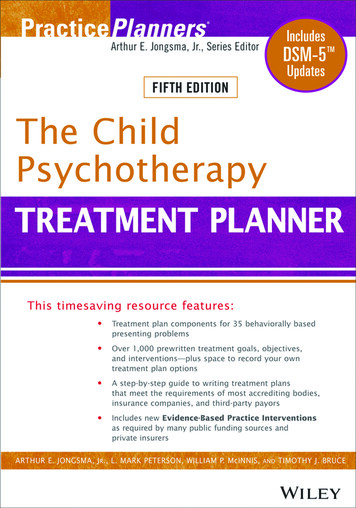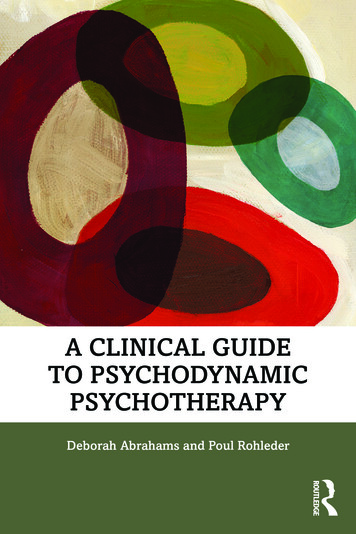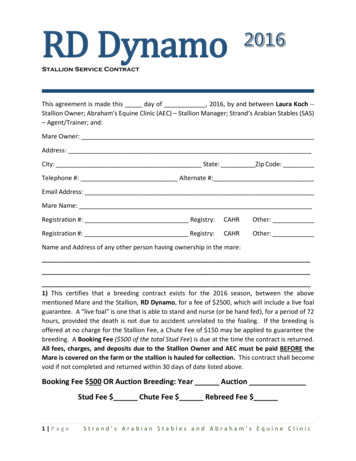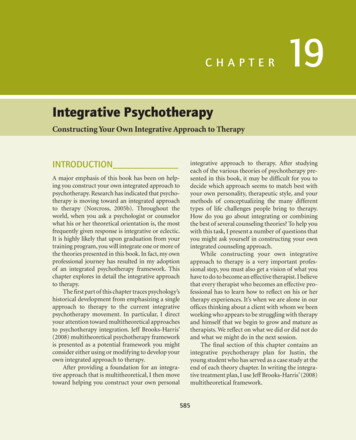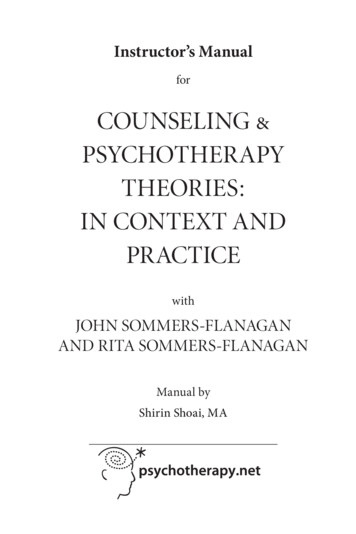
Transcription
ssionalPsychologyVolume2,201323Equine-Facilitated Psychotherapy as a Complementary Treatment InterventionCarissa Brandt, Argosy University, Twin CitiesAbstractAnimals have been positively influencing human health for centuries. Recently,an alternative therapy, animal assisted therapy (AAT), has been developed thatincorporates trained animals into a professional setting. The use of horses in atherapeutic context is a subset of AAT known as equine-facilitated psychotherapy(EFP). EFP has been incorporated into the healing process for a wide range ofbehavioral and mental health disorders. EFP is commonly used as acomplimentary intervention to empirically supported therapeutic interventions.During EFP, horses support clients’ development of positive behavior andemotional wellness through a variety of activities. There are several limitations toEFP as it is a developing therapeutic intervention. Despite the increasing use ofEFP within mental health settings, there is limited research supporting itsefficacy. Further research using methodologically rigorous designs are imperativegiven the rapid growth of mental health clinics using EFP to treat a diverse rangeof clinical populations.Due to the extensive documentation identifying positive outcomes of human-animalrelationships, a therapeutic technique has been developed that integrates animals into the healingprocess. This alternative therapy is often referred to as animal assisted therapy (AAT; Parshall,2003). AAT is the incorporation of animals into the therapeutic process. Specifically, AAT is agoal-directed intervention that is implemented by a qualified mental health professional using atrained and often certified animal (Delta Society, 2012). During AAT, animals act as a catalystbetween the client and therapist to promote therapeutic change and healing (Chandler, 2012).The goals of AAT frequently entail developing coping resources, social skills, and problemsolving strategies while fostering emotional and psychological well-being (Chandler, 2012;Lefkowitz, Paharia, Prout, Debiak, & Bleiberg, 2005).AAT has been used with diverse clinical populations, including individuals who havebeen diagnosed with autistic spectrum disorders, mood disorders, anxiety, trauma, and substanceuse disorders (SUDs; Parshall, 2003). Some research supports that the use of AAT may beespecially beneficial with difficult or resistant clients (Berget, Ekeberg, & Braastad, 2008;Chandler, 2012). Therapeutic interventions that incorporate animals have been found to increaseadherence to treatment, particularly with clients who demonstrate inconsistent attendance or lowmotivation for therapy (Beck, Serydarian, & Hunter, 1986). Additionally, AAT has been foundto be an effective therapeutic intervention across gender and age as well as cross-culturally (Dellet al., 2011; Geist, 2011). Due to the diversity of animals used, AAT is a flexible technique thatcan be utilized in a variety of settings. The most commonly used animals for AAT are dogs.
EQUINE-FACILITATED PSYCHOTHERAPY24However, several other animals have been incorporated into the therapeutic setting, includingcats, chickens, dolphins, and horses (Rothe, Vega, Torres, Maria, Soler, & Pazos, 2005). Horsesand dolphins create a unique therapeutic experience, as the client must go to the animal and itsenvironment (Ewing, MacDonald, Taylor, & Bowers, 2007).Equine-facilitated PsychotherapyThe incorporation of horses into the therapeutic setting is frequently referred to asequine-facilitated psychotherapy (EFP). During EFP horses become a therapeutic aide,supporting clients’ development of positive behavioral and emotional wellness. The humanhorse bond can help develop several skills that are often weak or lacking in individuals sufferingfrom behavioral or mental health disorders. Mutual trust, affection, patience, assertiveness, andresponsibility are just some of many abilities that horses bring out in people (Ewing et al., 2007;Rothe et al., 2005). Combining the natural bond that occurs between client and horse withtraditional psychotherapy techniques enhances the healing process in a way that is truly unique toEFP. The equine-human bond, in tandem with the client-therapist relationship, allows for theprocessing of painful emotions and experiences while simultaneously developing intimacy,identity, and partnership. This dual process creates an efficient and successful therapeuticprogram (Klontz et al., 2007; Yorke, Adams, & Coady, 2008). Clients report being less burdenedby guilt and fear as well as more independent and self-supportive following EFP sessions(Klontz et al., 2007). EFP has been found to enhance self-esteem, trust, relationships,interpersonal effectiveness, and overall feelings of well-being in participants (Rothe et al., 2005;Schultz, Remick-Barlow, & Robbins, 2006). Further, EFP has been found to significantlydecrease psychological symptoms in individuals with trauma or abuse, eating disorders,depression, anxiety, attention deficit disorder, or autism spectrum disorder (Rothe et al., 2005).Equine communicationDue to horses’ unique characteristics and uncanny ability to reflect human emotion, theuse of equines in the treatment of mental illness has become increasingly popular within the pastdecade (Trotter, 2012). Unlike cats or dogs, horses are prey animals and must be attuned to theirenvironment at all times to ensure survival. Thus, horses are excellent at remaining present in themoment and accurately interpreting environmental cues. Further, horses are highly social herdanimals and depend on continuous communication between members for safety (Frewin &Gardiner, 2005). Through observing and interacting with horses, there is ample opportunity toteach and develop social and relational skills. Because horses rely heavily on non-verbalcommunication, they become confused and agitated when there is incongruence between verbaland non-verbal cues (Vidrine, Owen-Smith, & Faulkner, 2002). When humans present withincongruence, horses instinctively react, reflecting the person’s internal emotional stateregardless of outward expression. Though some may tolerate more incongruence than others, allhorses will provide instant and direct non-verbal feedback to humans when they present withunclear intentions or mixed verbal and non-verbal cues (Frewin & Gardiner, 2005; Lentini &Knox, 2009). While the horse’s feedback is non-judgmental, it is very clear. When a horse feelsan emotion, it does not hesitate to express it (McCormick & McCormick, 1997).In contrast to horses, humans have become accustom to rigidly controlling theiremotional expressions and frequently demonstrate incongruence between their verbal and non-
EQUINE-FACILITATED PSYCHOTHERAPY25verbal communication. In an excessively technical and high demand world, it is all too easy forindividuals to become increasingly separate from their authentic experiences and feelings. Whenthis connection is weak or disconnected, mental illness can occur (Porter-Wenzlaff, 2007).Interacting with nature and animals helps many people rejuvenate their mind-body connection(McCormick & McCormick, 1997). Due to their willingness to express emotion, the use ofhorses in a therapeutic setting creates an effective medium through which clients are able toreconnect with their authentic selves. This can be seen from the moment an individual comesinto contact with horses. People frequently are drawn to a horse that reflects their personality,often feeling an immediate connection with horses that resonate with their core issues (Rothe etal., 2005).Transference. Transference is the reoccurrence of an individual’s unresolved thoughtsor feelings relating to a certain event or relationship (Klontz et al., 2007). Transference typicallyresults from an individual being reminded of his or her concealed thoughts or feelings. Becausehorses are considered emotional mirrors, they provide ample opportunity for transference toarise. Sending unclear non-verbal messages to a horse is irritating and confusing for the animal.If clients are not outwardly congruent with their emotional state, the horse will be uncooperative,agitated, and quickly lose respect and trust in the handler (McCormick & McCormick, 1997;Porter-Wenzlaff, 2007). Consequently, the horse’s disobedience creates negative feelings in theclient. When these emotions arise, transference typically takes place, providing an opportunityfor the client to process unresolved issues (Karol, 2007). As EFP progresses, clients begin tofocus on the horse’s behavior to understand how they are feeling and eventually begin to readilyknow their own emotional state, repairing and strengthening their mind-body connection (Davis& Hayes, 2011; Rothe et al., 2005).Metaphors. To facilitate transference, the use of metaphors is heavily incorporated intoEFP (Whitely, 2009). The client’s interactions with the horse are information for the clinician asto how the client may behave in other situations. The clinician then uses the horse as a metaphorfor relationships, behaviors, or events in the client’s world that have been problematic orchallenging in the past (Duckers, 2008; Klontz et al., 2007). Horses are particularly effectivemetaphors for relationships, as they are social animals and have designated roles within theirherd (Bachi, Terkel, & Teichman, 2011; Duckers, 2008). In observing the herd dynamic, clientsoften relate to horses that reflect their own relational values and beliefs (Bachi et al., 2011).Clients may resonate with low ranking horse(s) that are often pushed around by other herdmembers if they struggle with assertiveness or low self-confidence. Alternately, clients mayconnect with the dominant herd member if they are defiant, stubborn or struggling withbehavioral problems (Bachi et al., 2011; McCormick & McCormick, 1997). Further, clients maybe overly affectionate with the horse or too aggressive with their requests and actions. In eithersituation, the horse may move away from the client and disengage. In doing so, the horseestablishes a boundary with the client (Trotter, 2012). Using the horse as a metaphor, theclinician is able to incorporate examples from the “here and now” to facilitate a discussion onhealthy boundaries and relationships. The client’s interactions with the horse become examplesof potential consequences when boundaries are either too rigid or diffuse (Duckers, 2008;Nichols, 2011). The exploration of boundaries during EFP may be especially beneficial whenworking with couples or families. Because EFP is goal-oriented, the clinician is able to observethe family dynamics in the present while members work to accomplish a specified task. Through
EQUINE-FACILITATED PSYCHOTHERAPY26observing and discussing the family’s interactional patterns as they occur, insights arise that maygo unnoticed for a longer period of time within a traditional therapeutic setting (Nichols, 2011;Masini, 2010).Physical touch and boundariesEFP is considered a holistic approach, as it incorporates both physical and psychologicalcomponents (Bachi et al., 2011; Trotter, 2012). Non-erotic physical touch, such as hugging orholding or touching another person’s hand, arm, or upper back, is essential for human beings,often having a restorative and healing effect for those struggling with emotional or physical pain(Sexauer, 2011). Despite the benefits of non-erotic physical touch, it is often limited within atherapeutic context out of respect for the client and to ensure professional boundaries (AmericanPsychological Association [APA], 2010; Sexauer, 2011). The incorporation of EFP as atherapeutic modality, however, causes clinicians to re-evaluate the use of physical touch in thehealing process. EFP is a unique modality because physical touch frequently occurs between thehorse and client. Additionally, clinicians may need to touch a client in order to demonstrate aspecific skill or technique or to ensure client safety. Thus, boundaries surrounding physical touchbetween client and therapist need to be discussed and agreed upon by all eligible parties prior tocompleting an EFP session (APA, 2010; Chandler, Portrie-Bethke, Barrio Minton, Fernando, &O’Callaghan, 2010; Sexauer, 2011). Through frequently discussing and checking in with theclient about touch, the benefits and healing nature of physical touch can occur while the therapistis able to adhere to best practice guidelines and uphold professional boundaries (APA, 2010;Chandler et al., 2010; McCormick & McCormick, 1997).Horses are unique in that they are one of the only domesticated animals that are willing tobear human beings on their backs (Yorke et al., 2008). For this to take place, mutual trust andrespect must occur between both rider and horse. When on a horse’s back, the rider must bewilling to give much of his or her power over to the horse. Clients often find this experienceintimidating and uncomfortable. However, if it is embraced and the rider faces his or her fears,growth occurs and a healing relationship between horse and rider develops (McCormick &McCormick, 1997). Being in such a state of vulnerability to another living being encourages oneto face uncomfortable issues, such as hidden and often unresolved emotional experiences (Klontzet al., 2007). Additionally, the activity of riding frequently enhances the relationship betweenrider and horse and acts as positive reinforcement through fostering pleasure, intimacy, and asense of accomplishment (Bachi et al., 2011; Karol, 2007). This positive feedback is a strongmotivator for clients to continue participation in treatment. Motivation has repeatedly beenidentified as a powerful catalyst for change and can be readily facilitated within an accepting andempowering environment (Miller & Rollnick, 2002).The horse’s large stature and strength demands attention and respect (Ewing et al., 2007;Whitely, 2009). While a cat or dog can often be physically moved by a human, little can be doneif a horse does not want to comply with an individual’s requests given the animal’s sheer sizeand weight. However, if the request is made with respect, confidence, and intention, the horsewill readily respond and engage in the desired behavior or activity (Christian, 2005). As theclient learns how to communicate with and “move” a large animal, confidence in one’s abilitiesand a sense of accomplishment are instilled (Masini, 2010; Trotter, Chandler, Goodwin-Bond, &Casey, 2008).
EQUINE-FACILITATED PSYCHOTHERAPY27Nontraditional therapeutic settingBeing a large animal, the very nature of the horse requires EFP to take place in anontraditional therapeutic setting, typically outside or in an indoor barn or arena. Rather thanbringing an animal, such as a cat or dog, to the client’s environment, the client must be willing tomeet the horse in its environment (Schultz et al., 2006). Activities with the horse(s) arefrequently conducted in natural, outdoor settings, which may be more readily viewed by theclient as a relaxing and safe environment over traditional therapeutic settings (Bachi et al., 2011).Additionally, EFP may be less threatening and more engaging as the stigma associated withtreatment clinics and attending therapy is removed. Clients are able to reframe their initialnegative concepts of therapy into engaging, interactive, and positive experiences (Bachi et al.,2011; Dell et al., 2011). In doing so, resistance and reservations are lessened, allowing for deeperparticipation in the therapeutic process and enabling change to occur (Miller & Rollnick, 2002).Participating in equine activities, particularly when outdoors, also encourages the use ofboth verbal and non-verbal communication, as clients need to maintain awareness of themselvesin relation to their surroundings. To accomplish this, clients must be present in the moment andmindful of the body language of both themselves and the horse (Bachi et al., 2011). Throughattending to and validating the horse’s non-verbal cues, clients gain a better awareness andunderstanding of their own bodies. Often individuals with mental illness, specifically thosesuffering from trauma, eating disorders, or SUDs, feel disconnected with their physical bodies(Kehle et al., 2012). EFP sessions help clients to reconnect with their bodies. Over time,individuals are able to identify, validate, and attend to their non-verbal cues and emotions ratherthan suppress them with maladaptive behaviors (Davis & Hayes, 2011; Stauffer, 2006).While conducting therapy in a non-traditional setting has several benefits, clinicians mustalso be mindful of the risks and limitations that accompany an outdoor environment. Clientconfidentiality is of primary concern and professional standards should be upheld (APA, 2012;Cepeda, 2011; PATH, 2012). Additionally, safety of all involved parties needs to be a priority, asEFP takes place in an environment where accidents and injury could occur (Cepeda, 2011; Rotheet al., 2005). Horses also must be trained and thoroughly screened for appropriateness in EFPsessions. Horses have unique personalities and needs, and some may not be able to tolerate thestress and demands of being a therapy horse (PATH, 2012; Rothe et al., 2005; Trotter, 2012).That stated, when incorporated into treatment by a skilled and qualified mental healthprofessional, equines bring several unique qualities to treatment that enhance the therapeuticprocess and aid in facilitating client change (Karol, 2007; Rothe et al., 2005).Professional organizationsAs a therapeutic modality, EFP is in its infancy and a comprehensive theoreticalframework has yet to be established, including standardized terminology and guidelines. Toensure appropriate use of equines within a therapeutic setting, a number of organizations havedeveloped and implemented standards of practice within the field. Currently, there are fourprimary organizations that provide trainings and certifications for equine and mental healthprofessionals who incorporate horses into their practices.
EQUINE-FACILITATED PSYCHOTHERAPY28PATH. The Professional Association for Therapeutic Horsemanship (PATH), previouslyknown as North American Riding for the Handicap (NARHA), was established in 1969 andprovided the first safety standards and qualifications for certification of equine professionals(PATH, 2012). PATH is a non-profit, international organization that strives to promote“diversity and opportunity in equine-assisted activities and therapies” (para. 1). PATH prefersthe term “equine-facilitated psychotherapy,” as it emphasizes the horse’s role within thetherapeutic process while acknowledging that EFP is first and foremost psychotherapy. Asdescribed previously, EFP is defined as the incorporation of mounted and un-mounted equineactivities that are conducted by a qualified mental health and equine professional or a mentalhealth professional adequately trained and certified to work with horses in a therapeutic context(PATH, 2012; Krueger & Serpell, 2006). Due to the growing popularity of EFP, the Equinefacilitated Mental Health Association (EFMHA) was created in 1996 to solely address mentalhealth needs and services. In an effort to streamline models and guidelines, EFMHA wassubsumed by PATH in 2010. EFMHA’s model has been integrated into PATH’s ethical, safety,and professionalism guidelines for mental health professionals and equine specialistsimplementing EFP in practice (Tetreault, 2006; PATH, 2012).EAGALA. The Equine-Assisted Growth and Learning Association (EAGALA) is aninternational, non-profit organization that was established in 1999. EAGALA (2012) strives to“provide education, standards, innovation, and support to professionals providing services inequine-assisted psychotherapy and learning (EAP/L) around the world” (para. 1). EAGALAprimarily uses the acronym EAP to describe the incorporation of horses into the therapeuticprocess. EAP is defined as “a collaborative effort between a licensed therapist and a horseprofessional working with the clients and horses to address treatment goals” (para.1). EAP iscategorized as an experiential therapeutic technique that is brief and solution-oriented(EAGALA, 2012; Tetreault, 2006). The EAGALA model emphasizes groundwork activities as ameans to foster emotional growth and healing. Mounted work is not incorporated into treatment,as the model believes that EAP is not to develop riding or horsemanship skills; instead, activitiesare tailored to the mental health needs of the client (EAGALA, 2012; Tetreault, 2006).EAGALA prides itself on implementing rigorous ethical and practice standards, ensuringcertified members and clinics provide competent care to clients and adhere to best practices(EAGALA, 2012).CBEIP. The Certification Board for Equine Interaction Professionals (CBEIP) wasdeveloped in 2006 as a subdivision of the Delta Society, now Pet Partners (Pet Partners, 2012).CBEIP is a non-profit organization that emphasizes the need for increased credibility andprofessionalism within the EFP field, including standardized credentials across organizations andmodels (CBEIP, 2012; Trotter, 2012). CBEIP’s (2012) mission is “to set the bar for the higheststandards of best practices, knowledge, safety, effectiveness and consistency in equineinteraction therapy for all participants, including horses; [as well as] generate credibility andpublic trust in the practice” (para. 3). In doing so, CBEIP hopes to address the marked variabilitybetween current EAAT models. Further, CBEIP emphasizes the need for organizations tocollaboratively develop a globally accepted and standardized theoretical framework for the field(2012).
EQUINE-FACILITATED PSYCHOTHERAPY29EPONA. The EPONA approach was developed in 1997 (EPONA, 2012). The model isgeared toward equine specialists, but provides training for mental health professionals as well.Trainings and workshops emphasize a holistic approach and focus on leadership, personaldevelopment, equestrian skills, and instructor certification. The model pays close attention to anindividual’s relationship with the horse, the mind-body connection, emotional congruence, andboundaries (EPONA, 2012). Equine experiential learning (EEL) is the preferred terminologywithin the EPONA model, as the approach does not teach or integrate psychotherapy intosessions. The EPONA approach is less utilized than other EAAT models because it is criticizedfor being “too vague and unclear;” however, components of the model are often drawn upon orincorporated into other models (Dorotik, 2011).Implementing EFP in practiceProgress in EFP occurs through a variety of activities; many of these activities do notinvolve riding the horse. As clients advance in treatment, EFP activities become morechallenging. Clients typically begin with skills that establish trust and safe boundaries with thehorse (Ewing et al., 2007). The more commonly utilized activities include feeding, tacking,grooming, and leading. Once clients become comfortable around the horses, they are allowed toparticipate in groundwork, vaulting, and riding during EFP sessions (Frewin & Gardiner, 2005;Karol, 2007; Klontz et al., 2007).Groundwork. Feeding, tacking, and grooming are introductory skills (Porter-Wenzlaff,2007). These tasks allow clients to observe the horses’ behavior, learn safe handling techniques,and increase their comfort level with such large and powerful animals. Several sessions typicallyfocus on refining these basic skills. If a client is anxious, tense, or not fully present duringgrooming and tacking, the process is extremely difficult. The horse will sense the individual’sdiscomfort and react negatively, turning from the halter or refusing to lift its hoof when asked(Shultz et al., 2007). Once clients become aware of how their behavior affects the horse’sbehavior, they are able to work towards approaching the horse in a relaxed state. When thehandler is relaxed and open to the horse, the tacking and grooming process becomes a teameffort instead of a struggle (Karol, 2007).Once a client feels comfortable with introductory skills, leading is introduced. Leading isthe use of a halter rope to guide a horse. During the leading process, the handler walks along sideor slightly in front of the horse (Rothe et al., 2005; McCormick & McCormick, 1997). Severalemotions often arise within the client when the horse does not cooperate during the leadingprocess, allowing for transference to occur (Rothe et al., 2005; Yorke et al., 2008). Often theclient will either lead too tightly, wanting to restrict the horse, or too loosely, wanting to allowthe horse freedom. The horse responds accordingly, fighting the restraint or taking the rein andleading the client. Both of these actions reflect the client’s struggle for balance in his or her life(Rothe et al., 2005).Leading is typically a catalyst into other, more difficult activities. Leading uses a ropeconnected to the horse’s halter as a tool to have the horse move with the leaders (clients),whether they are walking around an outdoor arena or navigating through a maze. Groundwork isa more challenging EFP activity as it is conducted without a lead line. While in a small enclosedarena, the client asks the horse to complete specific tasks or movements with both verbal and
EQUINE-FACILITATED PSYCHOTHERAPY30non-verbal communication (Rothe et al., 2005). The client must have a commanding presencewhen communicating with the horse. If the request is unclear or hesitant, the horse will simplyignore it. If, on the other hand, the client is confident and clear with the request, the horse willlisten and eagerly respond (Porter-Wenzlaff, 2007). Groundwork is a difficult EFP activity formany clients. Individuals with a variety of behavioral and mental health disorders have difficultyexpressing emotion and strive to feel only numbness. Successful work with horses requires theclient to express these suppressed emotions (McCormick & McCormick, 1997; Sexauer, 2011).This can be a very painful, yet necessary experience. Once these emotions, and the memoriesassociated with them, are dealt with, the client will be more open to connecting with anotherliving being on an emotionally intimate level (McCormick & McCormick, 1997; PorterWenzlaff, 2007).Mounted activities. Mounted exercises (skills and activities performed on the horse’sback) are less common in EFP than activities performed from the ground. These exercises are forclients who are comfortable being around and handling horses. Typically, clients have hadseveral sessions of EFP before performing mounted exercises (Karol, 2007). However, whenincorporated appropriately, mounted skills are an effective influence on self-identity andconfidence. A horse represents power, grace, and vulnerability (Karol, 2007). Being on top of ahorse gives an individual a sense of these traits, instilling empowerment and confidence in therider. While the horse acts as a support system, the rider is able to explore the novel feelings in anon-judgmental environment. Through mounted exercises, clients who initially feel guarded andincapable, grow into self-assured and confident individuals (McCormick & McoCormick, 1997;Schultz et al., 2006).Therapeutic techniques and interventionsResearch supports that a multidisciplinary approach to treatment is most effective forindividuals with mental illness or dual diagnoses (Kleber et al., 2007). EFP is a flexible,complimentary therapy that can be effectively coupled with evidence based practices (EBPs) tomeet the unique needs of the client (Ratliffe & Sanekane, 2009; Schultz et al., 2006). EFP isreadily adaptable to individual, group, and family therapy sessions and activities are tailored tothe client’s unique treatment plan and goals (Ratliffe & Sanekane, 2009; Schultz et al., 2006;Trotter et al., 2008).Treatment structure. Typically, the client meets with the therapist in a traditionaltherapeutic (office) setting to complete an initial evaluation, establish a treatment plan and goals,and discuss the format for future sessions. It is important that the clinician discuss with clientstheir past experiences and comfort level with animals and equines (Rothe et al., 2005; Yorke etal., 2008). Care should be taken to ensure that the incorporation of equine activities is not rushed,particularly if clients present with fear or have little to no experience around horses.Additionally, safety considerations when working with horses are discussed prior to the initialEFP session and periodically throughout the treatment process (Beebe, 2008; Rothe et al., 2005).Following the initial session(s), the client is introduced to the horse(s) and introductory activitiesare conducted, including observing herd dynamics, grooming and stable chores, and groundwork(Cepeda, 2011). Clients build on learned skills, and equine activities become increasinglychallenging and may include mounted as well as groundwork. Therapy sessions oftenincorporate brief check-ins prior to and following each session as well as occasional full sessions
EQUINE-FACILITATED PSYCHOTHERAPY31within a traditional therapeutic setting. During the final session(s) of EFP, the therapist needs tobe mindful that clients are ending their relationship with both the therapist and the horse. Thus,care should be taken to address both losses (Cepeda, 2011; Chandler, 2012; Trotter et al., 2008).Throughout the course of treatment, therapists frequently incorporate EBP techniques into EFPsessions. Cognitive behavioral therapy (CBT), Gestalt therapy, person-centered techniques, andplay therapy are commonly utilized during EFP (Rothe et al., 2005; Schultz et al., 2006).CBT. CBT is a therapeutic technique that focuses on changing an individual’smaladaptive or unhealthy thoughts, beliefs, and behaviors. This is accomplished throughidentifying and reframing unrealistic or distorted thoughts as well as changing the affiliatedmaladaptive behaviors (Beck, 2011
When on a horse's back, the rider must be willing to give much of his or her power over to the horse. Clients often find this experience intimidating and uncomfortable. However, if it is embraced and the rider faces his or her fears, growth occurs and a healing relationship between horse and rider develops (McCormick & McCormick, 1997).
